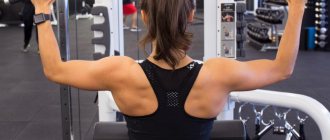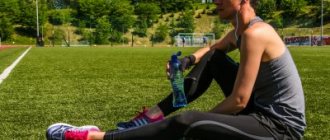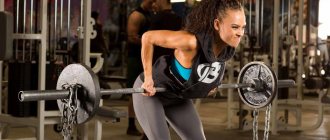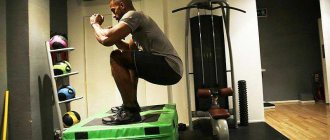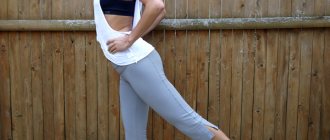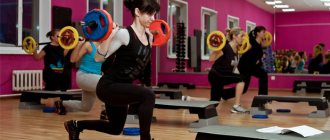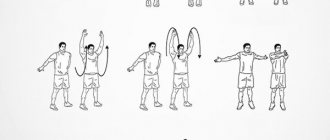So you've decided to lose weight. All you need to get things moving is proper nutrition and exercise. Follow the golden rule: spend more energy than you consume. It is important that the amount of food consumed is proportional to your daily activity. In sports, give preference to fat-burning workouts based on high-intensity exercise.
What affects the fat burning process in women?
- The female body contains more fat and less muscle than the male body. This affects your basal metabolic rate and how many calories your body burns after exercise.
- Women gain weight during menopause due to hormonal changes and a slower metabolism.
- Between 5 and 10 percent of women suffer from polycystic ovary syndrome. This condition is characterized by hormonal imbalances that make it difficult to lose weight and cause menstrual irregularities.
In addition, past illnesses, number of pregnancies, and much more may be determining factors. Despite this, the variety of training systems allows you to find the most optimal option for your rhythm of life and physical fitness.
Circuit training
This training system assumes that you alternately perform 5-7 exercises for different muscle groups without a break, and after completing the entire block of loads, rest for 1-3 minutes. Then repeat the exercise cycle again.
The main advantages of the circular training system:
- Accelerates metabolism and fights excess weight even after completing physical activity.
- Development and strengthening of the cardiovascular system.
- Improved endurance.
- Creating a load on the whole body, using all muscle groups.
- Ability to do exercises without equipment.
- The duration of the training is from 30 minutes to an hour.
Circuit training for weight loss can include both strength and aerobic cardio exercises. All exercises are performed with 12 repetitions or more. If the loads seem too easy, increase the number of repetitions or add weights.
The main advantage of circuit training is that it can be done at home, on the street and in the gym.
What exercises are suitable for home?
We offer 5 options without additional burdens:
Burpee
Involves different muscle groups and develops endurance, strength, and coordination. With high intensity exercise, high calorie consumption is guaranteed.
Crunches lying on the floor
Works the muscles of the legs and abdomen, is not traumatic and is suitable for beginners.
Climber
It is important that the abs are as tense as possible when performing the exercise. Make sure your weight is evenly distributed and your breathing is correct (pull your knee toward your chest as you exhale and straighten your leg as you inhale).
Lifting the pelvis while lying down
This is a basic isolated exercise that primarily works the buttocks. Important! The gluteal muscles should just touch the floor and rise immediately, do not lie on the floor and remain tense.
For more ideas, check out this article on full body training.
Examples of workouts
In this article I will look at the following types of training:
- Circuit training
- Bodyweight workout without equipment
- High volume low intensity training
- Low Volume High Intensity Training
All of these workouts (except the last one) are performed on the whole body. I give just such examples because they work very well for weight loss. There are also split workouts, which differ from weight gain workouts only by increasing intensity or volume; I will not consider them due to their triviality.
Circuit training
Circuit training is a type of high-intensity training. Its essence is to perform exercises in a row, one after another, with minimal rest. You can perform from one to three circles, the number of repetitions for each exercise is 12-15. Here's an example of one day of training using this program:
- Bench press
- Bent-over barbell row
- Leg press in the simulator
- Lying leg curls in the simulator
- Seated overhead press
- Shrugs
- Standing biceps curl
- French press
- Ab crunches on the floor with a plate
- Seated calf raises
It is recommended to train 3 times a week; in the second training session, it is advisable to replace multi-joint exercises with isolating ones, and in the third, choose other multi-joint exercises (for example, replace the bench press with a bench press on an incline bench). The order of exercises here is not random and should not be changed for better effect: chest, back, legs, shoulders, trapezius, biceps, triceps, abs and calves. In addition, it is necessary to do cardio training every day for 20-30 minutes. This could be running on a treadmill or any other type of cardio exercise.
Bodyweight workout without equipment
Bodyweight training without equipment has a number of advantages: you don't need a gym and you can train anywhere. Such workouts also involve almost all the muscles of the body and are highly intense. I’ll give you an example of my favorite workout, which, in addition to the fat-burning effect, can also help you increase your strength. All exercises are performed with a rest time between each approach of 30-45 seconds, 5 sets and 30 repetitions:
- Pushups
- Reverse push-ups
- Squats
- Ab crunches
- Plank (60 seconds)
- Diamond push-ups
- Jump Squats
- Burpees (3 sets of 15, 10, 5 reps)
- Lunges forward
It is recommended to do this workout at least three times a week. High-interval running for 15-20 minutes every day is recommended as a cardio exercise.
High volume low intensity training
In this example of a high-volume, low-intensity workout, we will perform multi-joint exercises along with isolation exercises. The number of sets and repetitions for multi-joint exercises (m) is 2x4-6, for single-joint exercises (o) 2x12-15, rest time between sets is 2-3 minutes.
- Incline bench press (m)
- Wide grip vertical pull-down (m)
- Leg press (m)
- Standing Dumbbell Lateral Raise (o)
- Standing dumbbell curl (o)
- Extension with a dumbbell from behind the head (o)
- Leg extensions in a sitting machine (o)
- Seated leg curls (o)
- Standing calf raises (o)
- Hanging leg raises (o)
This type of training should be done 3 times a week, with 45 minutes of low-intensity cardio performed on rest days. You can also vary the number of repetitions each week to vary the training and load different muscle fibers: 8-10 and 15-20, 12-15 and 20-30 for multi-joint and single-joint, respectively. It is recommended to change the exercises and their nature from time to time (for example, in the 1st workout you do a compound exercise on the chest, and in the 2nd an isolating exercise).
Low Volume High Intensity Training
Low volume high intensity training. Mostly multi-joint exercises will be used here. Also, in this program, not the whole body will be worked out in one workout, but the upper and lower parts separately. Training should be carried out 3 times a week. In the first week, you will do two upper body workouts with one lower body workout in between. Next week it will be the other way around.
Upper body:
- Bench press, 2 sets 8-12 reps
- Military press, 2 sets of 8 reps
- French press, 2 sets of 12 reps
- Reverse grip pull-ups, 2 sets of 10 reps
- Bent-over barbell rows, 2 sets of 10 reps
Lower body + biceps:
- EZ barbell curls, 2 sets of 12 reps
- Hammer curls with dumbbells, 2 sets of 12 reps
- Calf raises, 1 set of 15 reps
- Straight-legged deadlift, 2 sets of 15 reps
- Leg press, 1 set of 20 reps
Rest time between sets is 30-45 seconds. Each subsequent workout, vary the exercises, focus on compound ones, but from time to time include isolating ones.
Power training
For a balanced fitness program, strength training is essential. They prevent muscle loss, strengthen muscles and connective tissue, increase bone density, reduce the risk of injury, and relieve arthritis pain.
This type of exercise is especially important for people on a diet. When you lose weight, up to a quarter of the loss can come from muscle, which slows down your metabolism. Strength training helps restore them. Greater results can be achieved in the gym.
What exercises should I pay attention to?
Standing dumbbell lateral raises
One of the most popular exercises recommended by trainers for working out the middle delta. Particularly well displayed on posture and shoulders.
Ab exercise with a ball squeezed between your legs
If you don't have a ball, you can use a bottle of water or a rolled up towel. This will help diversify the workout, and also strain not only the abdominal muscles, but also the gluteal muscles, as well as the quadriceps.
Lunges with dumbbells
A universal exercise for both professionals and beginners. Pumps up the buttocks, thighs and calves. Make sure that your balance is not disturbed; the knee of the supporting leg (the one in front) should not protrude beyond the toe of the sneaker, and the back leg should form a right angle.
Rowing
It is performed on a special rowing machine. It uses the muscles of the legs, back and arms, and helps burn an average of 600 calories in an hour-long workout. Increases endurance and improves metabolism.
Deadlift
Works a variety of muscles including glutes, shoulders, back and hamstrings. In addition, according to research published in the International Journal of Sports Physical Therapy, deadlifts outperform the bar in targeting the deepest abdominal muscles, which act as an internal corset.
Exercise program to burn belly fat
The program presented below can be supplemented with workouts for burning fat - that is, regular cardio training (including aerobics), performed for 30-40 minutes in the fat-burning heart rate zone (about 110-130 beats per minute) at least 2-3 times a week.
Body weight squats
Warm-up exercise. Place your hands behind your head, tighten your abs and buttocks, then, as you exhale, slowly lower yourself down - as if sitting on a chair. Make sure your knees don't go forward. Hold for 1-2 seconds and rise up.
// Squats - what do they do and what muscles work?
Reverse crunches with a fitball
Exercise to strengthen the lower abs and the muscles of the back of the thighs. Lying on your back, as you exhale, move your arms with the ball back, while lowering your legs, and while inhaling, perform a twist - slowly and with a feeling of tension in your abdominal muscles.
// How to properly pump up your lower abs?
Swing your legs
An exercise to develop a sense of balance and to strengthen the abs and buttocks - in particular, the gluteus medius muscle, which gives it its characteristic roundness. As you exhale, lift your leg bent at the knee up, and as you inhale, lower it down. Make sure that your pelvis and shoulders are still.
// The best exercises for the buttocks
Burpee exercise
Burpee (stand-up squat with jumping up) is one of the most energy-intensive exercises and the best tool for burning fat from the abdomen and sides. It is a combination of four movements that involve almost all the muscles of the body.
// Burpee exercise - technique and benefits
Stepping onto a bench
One of the best exercises for the buttocks, also involving the gluteus medius muscle. The exercise quickly gives the gluteal muscles tone, which means elasticity and a rounded shape. Be sure to keep your abdominal muscles tense as you do this.
Side swings while lying down
From a semi-lying position, slowly lift your straight leg up, feeling the work of your lateral abs and buttock muscles. As you exhale, lower your leg down - then, without touching the floor, lift it up again. Make sure that your abdominal muscles are in conscious tension.
// How to pump up the side press?
Exercise Bicycle
Cycling is one of the key exercises for strengthening the lateral and transverse abdominal muscles. While alternating your legs, keep your stomach pulled in, your abs tense, and don’t lift your lower back off the floor.
// Exercise Bicycle - how to do it correctly?
Side plank with twists
An extremely effective exercise for strengthening the lateral abdominal muscles and creating toned abs. Useful both for developing balance and improving posture, and for reducing waist size. Starting position - side plank with your hand behind your head, then your elbow is pulled down.
// Plank for beginners – 4 best types
Side Lunges
Exercise for the oblique abdominal muscles, buttocks and thigh muscles. Step your right foot to the side, then, as you exhale, lower yourself down. Inhale and go back. Repeat for the other leg. Keep your abs tense. Perform the exercise at a fast pace, but pay attention to the technique.
Elbow plank
To increase the effectiveness of the plank exercise, perform it at the end of the training program, when the abdominal muscles are already tired - this allows you to burn more calories. The main secret of the technique is to ensure that your back is straight and your abdominal muscles are maintained in conscious tension.
// Plank - advanced technique and 25 variations
HIIT (high intensity training)
This is a system that will take your cardio training to the next level. Use running, the Stepper machine, rowing, jumping rope, cycling, etc. as exercise.
Intervals of physical activity and rest are usually measured in a 1:2 ratio. For example, a minute of intense running alternates with a 2-minute break. In total, a high-intensity workout takes from 5 to 30 minutes. The main condition is that during the period of physical activity you must give 100%, without sparing yourself.
This method helps burn excess fat and speed up metabolism. You will lose extra pounds even within 2 hours after your workout.
Morning workouts to burn fat
Ecology of life. Most competitive bodybuilders swear by the benefits of morning cardio before their first meal. They believe it helps them burn more fat and increases their metabolic rate for the day ahead. There are research results that support this point of view, but scientists and physiologists do not entirely agree with this.
Most competitive bodybuilders swear by the benefits of morning cardio before their first meal. They believe it helps them burn more fat and increases their metabolic rate for the day ahead. There are research results that support this point of view, but scientists and physiologists do not entirely agree with this. They support the energy balance hypothesis, which states that if you burn more calories than you consume in each 24-hour period, then it doesn't matter when you burn them or whether they come from fat or carbohydrates.
If you have even a basic knowledge of physiology, you must agree that the timing of your cardio training is not the most important factor in burning fat. Exercise when it suits you and follow a moderate diet - these are the most important rules.
However, there are arguments for early training on an empty stomach. They sound like this:
1. When you wake up in the morning after an 8-12 hour fast, your glycogen stores are depleted. Training under such conditions forces the body to mobilize fat, since there is not enough glycogen. 2. Eating food causes the release of insulin, which interferes with the mobilization of fats. The body has the least amount of insulin in the morning, which means you will burn the most fat at this time. 3. After a night's sleep, there are fewer carbohydrates (glucose) in your blood, which means you can burn more fat. 4. If you eat right before training, you will burn these carbohydrates, not fat. 5. When you exercise in the morning, your metabolism stays elevated all day. If you do your cardio in the evening, you'll only burn calories during that time, which is great, but you won't get the boost in metabolism in the hours that follow as you go to bed.
Scientists support this theory. Research conducted at Kansas State University and published in Medicine and Science in Sports and Exercise found that subjects burned a pound of fat faster when they exercised on an empty stomach in the morning than when they exercised at other times of the day. The researchers measured respiratory gas exchange, caloric expenditure, carbohydrate and fatty acid metabolism and found that calories released from fat burning accounted for 67% of total energy expenditure during exercise in the morning after a 12-hour fast. This is significantly higher than the 50% rate for those who exercised at other times of the day or immediately after eating.
Another study, published in the Journal of Applied Physiology, compared the effects of aerobic exercise on lipid oxidation between a full and an empty stomach. The researchers concluded: "Our results support the hypothesis that exercise training increases lipid oxidation in men following a 12-hour overnight fast." Here is an excerpt from the article “Optimizing Exercise for Fat Loss”: “The ability of exercise to selectively promote fat oxidation is optimal if exercise is performed on an empty stomach during the accelerated morning metabolism.”
Despite the fact that the fact of increased fat burning during morning aerobics seems quite logical and is supported by scientists, most physiologists do not agree with this. The main argument is that you can always find research that will support almost any theory you intend to defend. Interestingly, even gray-haired academics agree that you will burn more fat than sugar by exercising on an empty stomach. The real question is whether this affects overall fat loss over a long period of time.
Sports physiologist Greg Landry, author of The Metabolism System for Weight Loss and Fitness, says: “I agree that you burn slightly more fat as fuel when exercising on an empty stomach, but the real question is, does it really matter? I believe that there is a certain pool of calories stored in different forms throughout the body (fat, glycogen, etc.), from which we get calories to burn. If now we took a little more fat, then, probably, later the calories received from food will make up for its loss, since the glycogen stores at that time will be more complete. All this is transfusion from one vessel to another.”
Lyle MacDonald, bodybuilding nutrition expert and author of The Ketogenic Diet, agrees. He says the body compensates throughout the day and it's ridiculous to follow such a strategy: "All the research says is that you'll burn more fat by doing it this way, and I agree with that 100%. But while overall weight loss is happening, it doesn’t matter what exactly you burn, only the 24-hour calorie balance is important. If you burn glucose during exercise, you will burn more fat at other times of the day. If you burn fat during exercise, you will burn more glucose later. The end result is the same. If this were not true, then athletes such as sprinters who never burn fat in training would not be lean. They burn so many calories that they stay balanced and don't gain fat. So, while morning cardio does provide some psychological benefits for bodybuilders who enjoy this type of program, I wouldn't say it translates into overall body fat reduction at all."
When it comes to losing fat, there is hardly anyone more experienced in this matter than Chris Aceto. A high-level bodybuilder and nutritionist who has consulted with many of the world's leading bodybuilding professionals, Aceto is a firm believer in morning cardio training. He, without any doubt, states: “The fastest way to get rid of fat deposits is morning cardio training on an empty stomach.” He believes that looking at calories in and out only in terms of energy is "limited." Success depends on a number of factors, not just energy balance. We return to the age-old question, are all calories the same? “Absolutely not! - says Aceto. — A calorie is not just a calorie. Any physiologist shudders when he hears something like this.”
“All these people are talking about is calorie intake and calorie expenditure,” Chris continues. - Judging by their statements, if I eat nothing but candy and Coca-Cola and eat 100 fewer calories than I need to maintain my normal weight, I will immediately lose weight. We know it's not that simple. Don't forget about the ratio of carbohydrates, proteins and fats. Next comes meal frequency: We know from a lot of data that we will gain more muscle mass with 5-6 meals a day than with three. It's not just about calories, there are other factors."
There are more reasons why you should include morning cardio in your schedule. Landry, despite his doubts about the importance of the fuel source, Fr.
Here are a few more arguments in their favor: 1. They will make you feel great all day long, thanks to the release of mood-boosting endorphins. 2. They will nourish you with energy and invigorate you. 3. They will help regulate your appetite throughout the day. 4. Your biological clock will adjust to your morning workouts, making it easier for you to wake up in the morning. 5. Morning workouts will be more successful than those when you are tired from the work day and your friends tempt you to have a drink. 6. You can always find time to workout by setting your alarm a little earlier. 7. Morning workouts will raise your metabolic rate throughout the day.
Of all the benefits listed above, the most frequently discussed is the last one. Scientists call this phenomenon “additional post-exercise oxygen consumption.” Tracking just the number and type of calories burned during a workout won't give you the full picture. You also need to take into account the calories that your increased metabolism will continue to burn afterward. Yes exactly. Work out in the morning and you'll burn calories all day. Imagine sitting at work and burning fat! This is good, but the bad news is that the additional post-exercise oxygen consumption is not as great as many people think.
It's a myth that your metabolism stays elevated 24 hours after finishing your workout. This only happens after ultra-intense or prolonged exercise, such as a marathon.
After low-intensity training, the amount of additional post-exercise oxygen consumption is so small that its effect on fat loss is not worth talking about. You burn anywhere from 9-30 extra calories after exercising at an intensity of 60-65% of your maximum heart rate. In other words, just running on a treadmill will do little to boost your metabolism. Additional post-exercise oxygen consumption, however, increases with increasing intensity and duration of exercise. According to Wilmore and Costill in their Physiology of Sport and Exercise, additional post-exercise oxygen consumption after moderate exercise (75-80%) increases by about 0.25 calories per minute or 15 calories per hour. This will result in an additional expenditure of 75 calories. It seems like a small number, but if you do the math, in a year (in theory) you will lose an additional 2.5 kg of fat just from the calories burned after the workout.
High-intensity interval training allows you to achieve the best results.
You alternate periods of high (85% of maximum and above) intensity with short periods of low intensity. Studies of high-intensity interval training have demonstrated much higher additional post-exercise oxygen consumption, which can significantly increase daily energy expenditure. In one study, researchers at the University of Alabama observed the effects of two training programs on daily energy expenditure. The first group worked on exercise bikes for 60 minutes at medium intensity, the second trained according to a high-intensity interval training program: two minutes of high-intensity work on an exercise bike and two minutes of low-intensity work. The second group burned more calories in 24 hours than the first. All of this could result in a person losing an additional 5kg of fat over the course of a year, provided they do high-intensity interval training five days a week instead of regular exercise.
Paradoxically, lifting weights causes much more additional post-exercise oxygen consumption than regular aerobics. Research shows that metabolic rate remains elevated by 4-7% for 24 hours after training. Yes, this means that bodybuilding burns fat through some indirect mechanisms. For someone who burns 2,500 calories per day, this will translate into burning another 100-175 calories after finishing the workout. The lesson is simple: anyone who wants to get rid of excess weight and is not already involved in bodybuilding should first switch to weight training. Then, and only then, can you start thinking about morning cardio!
Everyone is interested in the consequences of aerobics, especially high-intensity exercise, in terms of the danger of losing muscle. After an overnight fast, glycogen, glucose, and insulin levels in the blood are low. As you can guess, these are optimal conditions for burning fat. Unfortunately, these same conditions are optimal for burning muscle because carbohydrates are low and levels of the catabolic hormone cortisol are high. It would seem that morning cardio training is a double-edged sword, but it is possible to avoid muscle tissue loss.
All aerobic exercise has some impact on your muscles, but as long as you don't overdo it, there's no need to worry about losing muscle tissue. It's true that your body breaks down muscle proteins for energy during aerobic exercise, but it breaks down and rebuilds muscle fibers all the time throughout your body. This process is called protein cycling, and it is necessary for normal life. Your goal is to increase its anabolic component and decrease its catabolic component just enough to remain in an anabolic state, that is, gain (or at least maintain) muscle mass.
How to build more muscle than you lose?
The first is to avoid excesses in cardio training. Aceto suggests limiting morning exercise on an empty stomach to 30 minutes, then "amino acids are less likely to be used as fuel." He also mentions that “a strong cup of coffee will help you burn more fat than glycogen. And if you can save glycogen, you can save protein.” You can also experiment with a thermogenic mixture of ephedrine, caffeine and aspirin, or similar herbal preparations.
The next point is to provide your body with proper nutritional support. Errors in diet are more likely to cause muscle loss than aerobics itself. To maintain muscle, eat healthy throughout the day, which includes adequate meal frequency, carbohydrates, proteins, and total calories. And third, train with heavy weights even during the fat loss phase. It's a mistake to think that light weights and high reps will help you get lean. What helps build muscle will also help maintain it.
Are you shocked by the prospect of losing hard-earned muscle, but still want to benefit from fat-burning morning cardio? One option that many bodybuilders resort to is a protein meal or shake 30-60 minutes before their morning workout. Protein without carbohydrates minimizes the insulin response and allows you to mobilize fat, while simultaneously supplying the body with amino acids that prevent the breakdown of muscle fibers.
Obviously, morning cardio training has a number of undeniable benefits that make many people get up a little earlier in the morning. But let's try to summarize. Do morning workouts actually lead to greater fat loss than workouts done at other times of the day? Experience, common sense and experimental results suggest that yes. However, the debate continues and further research is needed. While scientists in their labs are busy measuring gas exchange, calorie expenditure, and basal utilization levels, I intend to continue getting up at six in the morning to hop on the cardio machine. published
PS And remember, just by changing your consumption, we are changing the world together! © econet
Tabata system
The Tabata system is a subset of HIIT interval training. The exercises last from 4 to 30 minutes and do not require additional equipment or exercise equipment.
Tabata improves metabolism and also serves as a catalyst for fat burning. What needs to be done? Maintain intervals: 20 seconds of intense exercise and 10 seconds of rest, alternate them in this sequence 8 times (4 minutes in total). For the next 4-minute block, perform another exercise using the same principle. It is important that the loads are aimed at different muscle groups and work different areas of the body. You can use both cardio and strength training.
Example of a Tabata protocol workout
Combination of aerobic and anaerobic exercise
For many, strictly counting seconds and tracking intervals while doing exercises is stressful and puts pressure on them. In this case, simply alternate between strength and cardio exercises at a pace that suits you. In order for the training program to be competent, it is better to contact a trainer who will help you create an individual program that is suitable for you.
Thanks to this, you will simultaneously build muscle mass and lose excess weight. As a result, active fat-burning workouts will help you get a sculpted, strong, lean and resilient body.
Half-hour classes at FitCurves include warm-up, strength and cardio exercise, cool-down and stretching. At the same time, you will receive individual support and advice on proper nutrition.
